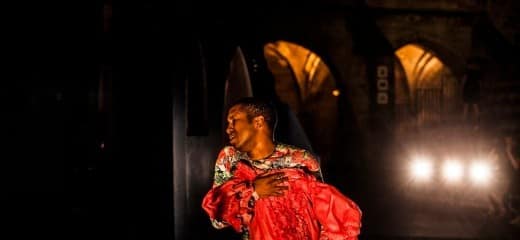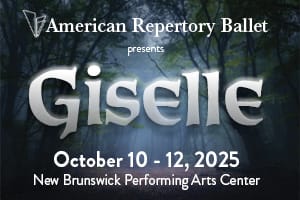In the front: the hoochie.
In the back: the coochie.
We’re attending an imagined rendering of a hoochie-coochie show—bastardized versions of a performance by Syrian dancer Little Egypt at the Chicago World’s Fair in 1893 (Europeans and Americans propagated these exoticized, orientalist peep shows into the 1980s)—at FringeArts, in 2018.
In the front: a set wall painted blue with the outline of an “orientalish” house. Blocky and flat, it bifurcates the space at a slight diagonal. A carpet softens the designated stage floor.
In the back: at first, nothing much. Exposed 2 x 4s.
In the front: choreographer Trajal Harrell. A silky button-up shirt drapes his body, his moves echoing its texture and feel—fluid, soft, delicate. He dances, eyes closed. His expression wavers through what appears to be pain, ecstasy, joy. Harrell emits a subtle but palpable frequency. Available, not entirely accessible. Performed, certainly, not entirely frontal.
In back: three dancers (Thibault Lac, Perle Palombe, and Ondrej Vidlar) clad in bathrobes, flip-flops, and street clothes cross from backstage to the onstage backstage, hauling a suitcase, a cardboard box labeled “foam roller,” Corn Pops, plastic bins. It’s like they’re moving in—a performance of ordinary, pedestrian rhythm, exposed to view, with a postmodern wink.
An audience plant stands up and situates us in Caen Amour, invites us to read the “Choreographer’s Notes,” to drink, shows us how and when to move from the back to the front, front to back, as we please. Go ahead, peep.
In front: entering through a cut-out door, performers strut, serve, and slay in duet with creatively repurposed costume pieces—a pair of pants, not worn but puppeteered at the hip. Pants and performer, an echo of swooshes and sways. A blanket fashioned as a skirt, a twirl flashes the glimpse of an ass crack.
In back: a dressing room with props signaling the feminine: quilts, Kleenex, tampons, women’s magazines, Windex, lotions. How titillating to cross into the backside, another world revealed, albeit staged.
In front: with apparent glee, a naked woman thrashes behind some kind of gown, bunched over her crotch. She spends more time naked than the male dancers do. This makes me uneasy, though she wears it comfortably. Perhaps it’s my own discomfort as spectator thrust into recognition.
In back: two male dancers put on a shirt and suit made for a Siamese twin. Costumed, the freak show never leaves backstage. Instead, they sit. For us? For them?
With access to all sides, perceptions of front and back shift. Assumptions about authenticity or privacy or resistance slide and waver. A naked female form dances behind a dark sheer fabric speckled with tassels—the shadow of a mutable trickster.
Caen Amour, Trajal Harrell, FringeArts, Sept 13-15






